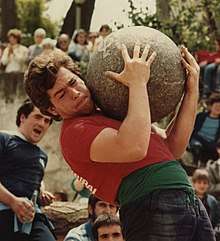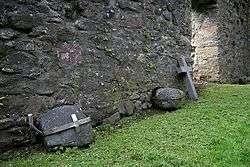Lifting stone
Lifting stones are heavy natural stones which people are challenged to lift, proving their strength. They are common throughout northern Europe, particularly Scotland, Wales, Iceland (where they are referred to as steintökin), Scandinavia and North West England centred around Cumbria.

Recently, lifting stones have been incorporated into the World's Strongest Man competitions, using various cast, found, or established challenge stones such as the Húsafell Stone. They also do a stylized version of an event derived from an ancient contest, in which men would see who could load the heaviest stone onto a stone wall, derived from building such a wall, where they are known as Atlas Stones.[1]
Iceland
In Iceland, lifting stones were traditionally used to qualify men for work on fishing boats. One such set of stones can be found on the beach of Djúpalónssandur at the foot of Snæfellsjökull. Another set can be found at Hvallátur. To qualify, a man would have to lift at least the hálfdrættingur stone to hip-height onto a ledge. Lifting heavier stones would entitle the man to a greater share of the catch.
The stones at Djúpalónssandur are classified as:
- amlóði ("useless") at 23 kg (50.7 pounds)
- hálfdrættingur ("weakling") at 54 kg (119 pounds)
- hálfsterkur ("half strength") at 100 kg (220.5 pounds)
- fullsterkur ("full strength") weighing 154 kg (339.5 pounds)
One of the most famous Icelandic stones is the Húsafell Stone which weighs 186 kg (410 lb).
Faroe Islands
Every settlement in the Faroe Islands used to have its local lifting stone, called a hav,[2] derived from the verb hevja which means 'to lift'. Visiting men would be challenged by the locals to show off their strength.
One such stone is now part of a mural in the village of Mikladalur. Known as ‘Marjunar hav’, it is said to have been lifted by Marjun - a milkmaid in the 16th century. [3]
Scotland
Clach cuid fir
Clach cuid fir, Gaelic for "manhood stones", originate from Scotland. Manhood stones were used for centuries as tests of strength in Scotland. Typically, a young man was welcomed into manhood when he was able to lift his clan's testing stone to waist height.[4] There are many examples in Scotland including:[5]
- the McGlashen Stones
- the Inver Stone (121.6 kg (268 pounds))[6]
- the Dinnie Stones (two stones weighing 332.49 kg (733 pounds) combined. 188.02 kg (414.51 pounds) and 144.47 kg (318.5 pounds))[7]
- the Menzies Stone (115 kg (253.5 pounds))[8]
Both the McGlashen Stones and the Dinnie Stones have been used in numerous Strongman competitions since the 1980s including World's Strongest Man and Pure Strength.
Clachan-ultaich
A Clach-ultaich (pronounced [kʰl̪ˠaxˈul̪ˠt̪ɪç]; plural clachan-ultaich) is another type of lifting stone found in Scotland. Examples are:
- the so-called Clach-ultaich Iain Ghairbh MhicGilleChaluim Ratharsair, "the lifting stone of Iain Garbh MacGilleChaluim of Raasay", in Duntulm on the Isle of Skye. Its weight is said to be a ton.[9]
- the Charter or Blue Stones of Dailly in Ayrshire are a pair of lifting stones located in the cemetery of Old Dailly church.[10]
- MacLeod's Lift (Scottish Gaelic: Ultach Fear Hiort lit. "St. Kildan's Lift") on Rona, names after one John MacLeod who was at one time tacksman and steward of St Kilda.[11]
Lifting Stane

Near Auldgirth in Dumfries and Galloway is a small farm named Liftingstane where a large stone with an iron handle once stood that was used as a test of strength.[12]
At Old Dailly in South Ayrshire are the 'Blue or Charter Stones' that were used for trials of strength to the extent that the local council has bound them with metal bands to prevent their continued use.[13]
The 'Leper's Charter Stone' at Kingcase in Prestwick, South Ayrshire was made of black basalt and kidney shaped, used as a lifting stane until it was broken although the parts remain, built into the walls of the old chapel.
Others
The Ardblair stones are a series of nine concrete spheres ranging in weight from 18 to 152 kilograms. They are used in the Blairgowrie & Rattray Highland Games.
Wales
According to Y pedair Camp ar Hugainyn Welsh for "24 feats of a welshman", stone lifting was a common practice. Usually performed by young boys as a rite of passage into manhood. It is said that once a young boy can lift the stone to his waist he was considered a man. Furthermore, the stone was used to develop a man's strength in preparation for battle.
There was no set size, shape or weight for each stone. Stones varied, depending on what was available within the locality or by what was selected by the king of each region.
The king's Teulu ("personal army") were selected from each village or town within his borders, based upon a man's ability to lift stones, run, jump, leap, wrestle, fence, shoot a bow and arrow and throw a spear.
To date, a lifting stone "Y Garreg Orchest" is still in place in the town of Criccieth in Gwynedd, North Wales. Competitors travel from all across the UK to attempt to lift this mammoth stone. In 2015 there was one successful lift of the 28 stone Goliath.
Basque Country
Stone lifting is also a traditional Basque Country sport involving the lifting of stones, called harri jasotzea. There are several varieties, particularly using round stones and rectangular ones. The goal can be raising and dropping a stone of certain weight as many times as possible or simply raising a heavy stone once in order to beat an existing record.
Carrying variants
The "stone carry" or "stone walk" is a traditional Scottish and Icelandic athletic event involving the carrying of large stones down the field of competition. This type of event has become very popular in the sport of Strongman, with many variations being used in numerous competitions all over the world.
The rules are simple: the competitors each pick up a pair of very heavy stones equipped with iron handles, and carry the paired stones as far down the field as they can. The length of the field varies depending on the site, but a hundred feet is typical. This event is also known as the farmer's walk.
If two or more competitors carry the stones the entire length of the field, heavier stones are then used. At the New Hampshire Highland Games, the record carry (as of 2004) is a pair of stones weighing 508 pounds (230 kg) carried just under 100 feet (30 m).
The game probably originated as an outgrowth of the need to clear stones from agricultural fields to create clearance cairns.
A similar Basque sport is the ontzi eramatea, where the weights were originally milk canisters.
See also
- Chikaraishi, the Japanese equivalent
- Stone put
- Strongman (strength athlete)
References
- "How to make an Atlas Stone". bodyresults.com. Archived from the original on 2015-06-19. Retrieved 2015-06-18.
- Visit Esturoy Archived 2014-03-05 at the Wayback Machine, pages 7 & 12
- "Marjunar Hav". Retrieved 2020-03-15.
- "Archived copy". Archived from the original on 2011-07-23. Retrieved 2011-10-25.CS1 maint: archived copy as title (link)
- "Archived copy". Archived from the original on 2011-07-23. Retrieved 2011-10-25.CS1 maint: archived copy as title (link)
- http://sportsillustrated.cnn.com/vault/article/magazine/MAG1095572/index.htm
- http://www.thedinniestones.com/Photo%20Gallery/Dinnie%20Steens%20Weight%20Cert%202014.pdf
- http://www.menzies.org/newsletters/2/newsletter2.htm
- Dwelly, Edward (1911), Faclair Gàidhlig gu Beurla le Dealbhan/The Illustrated [Scottish] Gaelic-English Dictionary (4th ed.), Glasgow: MacLaren & Sons
- Love, Dane (2009). Legendary Ayrshire. Custom: Folklore: Tradition. Auchinleck : Carn Publishing. ISBN 978-0-9518128-6-0 pp. 16 - 17.
- Robson, M. Rona the Distant Island (1991) Acair ISBN 0-86152-823-9
- Watson, R. (1901). Closeburn (Dumfrieshire). Reminiscent, Historic & Traditional. Inglis Ker & Co. p. 54.
- Love, Dane (2009). Legendary Ayrshire. Custom: Folklore: Tradition. Carn Publishing. pp. 16–17. ISBN 978-0-9518128-6-0.